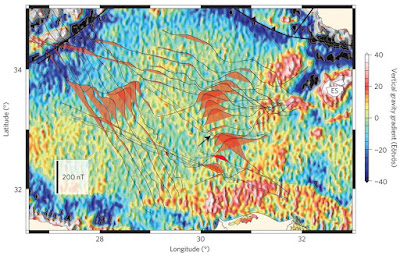 |
| Faulted basalts at the mid Atlantic ridge |
Amongst the breakthroughs which vindicated Wegener was the discovery of the liquid mantle on which the crust floated and the identification of fossil assemblages which hinted at successive reconfigurations of ancient continents.
Yet the biggest breakthrough was the discovery of seafloor spreading. Sampling of the Atlantic seabed had shown that it was composed of basalt and the volcanic source of the rock to be a linear extrusion zone in the middle of the ocean – the mid ocean ridge. Magnetic surveys revealed on either side of this ridge stripes of basalt which had been polarised in alternating directions by the reversals of the Earth’s magnetic field. Today this mirrored magnetic ‘bar code’ is the classic signature of a spreading centre and of the formation of new ocean seafloor.
The Atlantic was the first place where this bar code was identified and since then it has been identified in the Pacific. As new ocean floor is generated on one side of a tectonic plate, however, it is destroyed by subduction on the opposite, As such the oldest identified oceanic crust was from the mid Jurassic at just 180 million years old. Recently, however, a far older bar code was found in the Mediterranean. Collection of tectonic data about the Mediterranean basin has been limited by the thick sedimentary layers covering its bottom. Magnetic surveying by a team led by Roi Granot from the Ben-Gurion University of the Negev, Israel, found a bar code signature dated at 340 million years old – early Carboniferous.
 |
| The red tracks show anomalous magnetic data, indicative of the ancient bar code pattern of the Tethys seafloor |
This interpretation is intriguing as Tethys was thought to have formed during the breakup of Pangaea 300 million years ago. This new piece of evidence, suggests that the ocean was much older than previously thought.
‘With the new geophysical data, we could make a big step forward in our geological understanding of the area,’ said Granot.
In addition to its impact on regional geology, the opening of Tethys had a major impact on the biosphere due to the new epeiric ocean ecosystems that began to form. The earlier origin of the ocean therefore has important implications for the evolution of the new marine taxa during the Carboniferous.